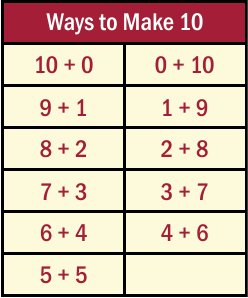Summary
In this lesson, students use ten frames to help them develop an understanding of numbers. This lesson starts with a Think and Read story called "Let's Play Soccer." The story is designed to capture students' interest in counting and solving age-appropriate real-world problems. Multiple games using mini ten-frame cards gives students extra practice at varying levels. The lesson closes with another short story and an opportunity for students to be creative by drawing and writing about numbers. This lesson is accompanied by a Parent Guide for at-home use.
Essential Question(s)
How can numbers help us in everyday life?
Snapshot
Engage
Students listen to the short story, "Let's Play Soccer." Students then draw a picture of the story and write a number sentence to show how they think Larkin and Jamar solved the ball problem.
Explore
During this activity, make sure students understand what a ten-frame is and how to use one. Students then explore by using an actual ten-frame and counters to solve the problems in the handout called "Make Ten With the Coach."
Explain
Students listen to a children's book such as Ten Flashing Fireflies by Philemon Sturges or Ten for Me by Barbara Mariconda. Together have the class create a "Ways to Make Ten" chart. Students then work in pairs to play ten-frame games.
Extend
After reviewing the original story, "Let's Play Soccer," students listen to a new story, "Sparky Comes to Play." Students write and draw their own story ending and then practice writing number sentences that are combinations for the number ten.
Evaluate
The assessment can be done as a whole class, in small groups, or individually. Using a ten-frame shown or drawn on the board, the students are asked to reason and explain their thinking to a variety of ten frame questions.
Materials
Let's Play Soccer (story and activity sheet attached)
Sparky Comes to Play (story and activity sheet attached)
Double Ten-Frame for each student (attached): Print and cut out the attached ten-frame sheet or make your own on a plain piece of paper
Ten-Frame Game Cards (attached): Cut the cards out on the dotted lines or make your own on index cards or paper rectangles
More Fun With Ten Frames Game Sheet (attached)
Make Ten With the Coach (attached)
Ways to Make Ten (attached)
More Ways to Make Ten (attached)
Counters: You can use cereal, buttons, dried beans, coins, raisins, etc.
Paper and pencil
Crayons or markers for drawing
Engage
The story, "Let's Play Soccer," introduces a math problem that happens during soccer practice. Prior to reading the story, ask students what kind of games or sports they like to play or what they play at recess. Then read the story, "Let's Play Soccer," aloud to students.
After reading the story, have the students draw a picture of the story and write a number sentence to show how they think Larkin and Jamar solved the ball problem.
Sometimes the words "Number sentence is used instead of equation." They are the same thing. Use the terminology that is used at your school. You may want to have students use a ten-frame and counters with this story problem.
Vocabulary to introduce while reading and working with this lesson: coach, soccer, soccer practice, ten-frame, counters, number sentence, problem, solved.
Explore
Have students work on the problems presented in the handout titled "Make Ten With the Coach." Ask student to place counters on their ten-frame to show how many balls were initially in the problem and then how many are needed to make ten.
Thinking questions to ask students as they work on the problems:
What can you tell me about the way the number looks on your ten-frame?
How does knowing you have a full row help you find how many you still need?
Explain
While reading the book the first time, ask students to notice the number combinations for the number 10.
During a second reading of the book, fill in the "Ways to Make Ten" chart. If you choose not to use a book, use the solutions from "Make Ten With the Coach" to help students complete the chart. Record the combinations in the order in which the children and the book suggests them. The order is not important at this time.
The chart should look something like this when completed.

When students are ready, they can build another chart for other numbers or complete the "More Ways to Make Ten" chart. This chart will include combinations such as 3+ 2+ 5 or 11-1 or 12-2.
Extend
After reviewing the original story, "Let's Play Soccer," read the story "Sparky Comes to Play."
Students will write and draw their own story ending. You can use the attached hand-out or plain copy paper for these activities.
Once they have written their own story ending, pose the following question: What do you think would happen if we put 9 more soccer balls in the yard for Sparky to play with? Students respond by writing a number sentence to answer the question. Continue by asking students what they think would happen if they added 2 more balls, 6 more balls, 12 more balls, and so on. Allow students to use their ten-frames and draw and write about as many scenarios as they want.
Evaluate
This assessment can be done as a whole class, in small groups, or individually.
Draw a ten-frame on the board.
Ask:
How many boxes are in the ten-frame? How did you figure it out?
How else could we figure out whether there are ten boxes in the ten-frame?
Why is a ten-frame called a ten-frame? Explain your thinking.
Next, show a ten-frame with five dots inside the ten-frame. Place only one dot in each box. Ask the following questions:
How many dots are in the ten-frame? How did you figure it out?
How many dots would we need to make ten? How do you know?
Repeat steps 1 and 2, changing the number of dots inside the ten-frame.
Resources
Grandma "B" Reads With Me. (2016, June 26). Ten Flashing Fireflies by P Sturges [Video]. YouTube. https://youtu.be/aKvUvrw4lNE
Kindergarten Storytime. (2020, April 17). Ten for Me by Barbara Mariconda with Miss Kish [Video]. YouTube. https://youtu.be/X2WRYvh9mfc
Mariconda, B. (2011). Ten for Me. Sylvan Dell Publishing.
Miss Pam Reads. (2018, February 1). Ten Black Dots [Video]. YouTube. https://www.youtube.com/watch?v=uPJEqUB2CxA
Mr Little's Virtual Classroom. (2020, October 1). Mr Little's Stories - "How Many Legs?" by Kes Gray & Jim Field [Video]. https://www.youtube.com/watch?v=YXtUxRnykMk
Sturges, P. (1995). Ten Flashing Fireflies. NorthSouth Books.
Van de Walle, J. A. (2016). Elementary and Middle School Mathematics: Teaching Developmentally. Pearson Education Inc.


